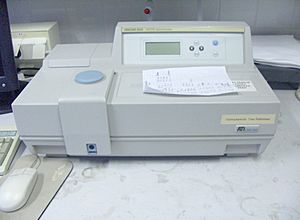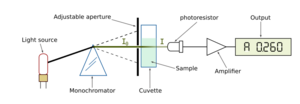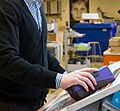Spectrophotometer facts for kids
A spectrophotometer is a cool scientific tool. It helps us understand how much light a substance either soaks up (absorbs) or bounces back (reflects). Think of it like a special light meter for tiny samples! The study of light using these machines is called spectrophotometry. It helps scientists learn about different materials by looking at their unique light "fingerprints."
Contents
How a Spectrophotometer Works
Modern spectrophotometers work in a few simple steps:
- First, a light source shines light onto the sample you want to test.
- Some of this light either passes through the sample or bounces off it.
- This light then goes into a special part called a monochromator.
- The monochromator acts like a prism, splitting the light into its different colors (wavelengths).
- Finally, a detector measures how much of each color of light is present.
Types of Spectrophotometers
There are two main types of these machines: single beam and double beam.
Single Beam Machines
A single beam spectrophotometer measures light in one path. It first measures the light before it goes through your sample. Then, you put your sample in, and it measures the light again. It compares these two measurements to see what happened to the light. These machines are often smaller and simpler. They can also measure a wider range of light types. Sometimes, they are built right into other devices like microscopes.
Double Beam Machines
A double beam spectrophotometer is a bit more advanced. It has two paths for light. One path goes through your test sample. The other path goes through a "reference" sample, which is usually just a blank or a known material. The machine compares the light from both paths at the same time. This makes the measurements more accurate and stable.
Calibrating the Machine
Many older spectrophotometers need to be "zeroed" before you use them. This means you tell the machine what "no absorption" looks like. You might use a blank liquid or a special reference material. Once it's zeroed, the machine can then accurately measure how much light your actual sample absorbs compared to that starting point.
Measuring Glow (Luminescence)
Spectrophotometers can also measure something called luminescence. This is when a substance gives off light after it has absorbed energy. For example, the machine might shine ultraviolet light on a sample. This light can make the sample glow. The spectrophotometer then measures the light that the sample glows back, often at a different color. This helps scientists study materials that naturally glow or can be made to glow.
Images for kids
See also
 In Spanish: Espectrofotometría para niños
In Spanish: Espectrofotometría para niños






